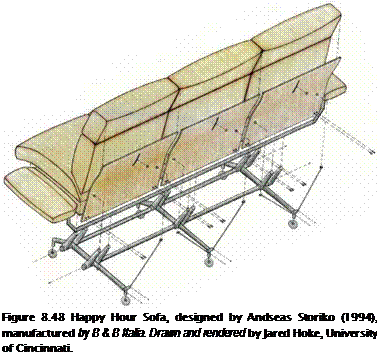Upholstered furniture has been around since ancient Egypt, with seat pans made from various grasses. During the Renaissance, leather and velvet were applied to furniture. In 1620, the English Upholsterer’s Company was granted a charter. It is one of the oldest of the London guilds and liveries companies. Traditional notions of upholstered furniture include pieces made with filling materials and covered with a surface material, but upholstery also includes furniture that uses jute, hemp, exposed web, or seat pans made of reed or other caning materials.
Upholstering in the seventeenth century developed from several trades, including that of the cofferer, who was responsible for using leather as a covering for trunks and later for chair seats; the saddler, who made saddles; and the tapissier, who supplied canopies, wall tapestries, table carpets, and tent makers. Tent making was a job for upholsterers, and it is not surprising that the coat of arms for the upholsterer’s guild had three tents emblazoned on a shield.
In Europe during the eighteenth century, new concepts of upholstered furnishings and comfort emerged during the French Rococo period. As a result of the Industrial Revolution, fully integrated and upholstered furnishings became common throughout the world. Upholstered furniture reached its zenith in the late Victorian and early Edwardian eras.
The journeyman upholsterer is considered a furniture-making specialist. Upholsterers built on a frame of wood or metal furniture padded with stuffing. This required measuring, cutting, and fixing soft material to the frame of furniture, and for the most part was a handcraft vocation. The industry grew so competitive that in the 1930s upholstery sweatshops were common. These shops often produced the cheapest and poorest-quality upholstered furniture.
Many chairs designed and fabricated between the 1930s and 1960s were handcrafted and used hemp webbing, halyard, cane, or braided paper to support the seat pan or human body while sitting. The craft of the woven seat pan in Hans J. Wegner’s classic The Chair (Figure 8.45) is remarkable, as is Jorgen Havelskov’s Harp chair (1968), made of ash and halyard.
|
Figure 8.45 The Chair—cane woven seat pan and backrest, designed by Hans J. Wegner (1949), fabricated by Johannes Hansen. Photography by Jim Postell, 2006. |
By the 1950s, advances in polymer technologies had generated new ideas about color, shape, and form in upholstered furnishings. This technology advanced an ongoing investigation into ergonomics and sculpted form. Upholstered furniture often hid the structural elements of its frame. Formal ideas of biomorphic form began to drive design. Upholstered furniture examples include a wide range of furniture types, but the basic pieces were sofas, chairs, sectionals, ottomans, and sofa beds.
Conventional upholstered furnishings utilized woven springs and integrated bedding assembled by hand (Figures 8.46 and 8.47). Today, machine production and integrated
|
Figure 8.46 Upholstery in the making—Rud. Rasmussen, Copenhagen, Denmark. Photography by Jim Postell, 2006. |
|
Figure 8.47 Upholstery in the making—showing various types of materials: lumber, nails, staples, and wire. Photography by Jim Postell, 2006. |
foam-injected molds have revolutionized the production of upholstered furniture and, for the most part, have improved its structural integrity.
 B & B Italia produces integrated upholstered chairs and sofas that utilize the latest fabrication technologies, in which the structural elements are completely integrated in both the design and fabrication of the expanded foam components. The Happy Hour sofa, designed by Andreas Storiko (1994), is a transformable upholstered sofa that adjusts for different postures (Figure 8.48).
B & B Italia produces integrated upholstered chairs and sofas that utilize the latest fabrication technologies, in which the structural elements are completely integrated in both the design and fabrication of the expanded foam components. The Happy Hour sofa, designed by Andreas Storiko (1994), is a transformable upholstered sofa that adjusts for different postures (Figure 8.48).
Reclining chairs are a subcategory of upholstered chairs, including upholstered rockers and swivel chairs. Recliners can have adjustable backs and built-in footrests that allow a person to recline in a number of different positions. The original recliner was the Morris chair, named after the designer William Morris. The Morris recliners of the mid-1800s were bulky and required a significant amount of space to function properly. Advances in the reclining mechanism have greatly reduced the size of these chairs.






